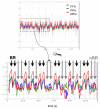Nonlinear dynamic causal models for fMRI
- PMID: 18565765
- PMCID: PMC2636907
- DOI: 10.1016/j.neuroimage.2008.04.262
Nonlinear dynamic causal models for fMRI
Abstract
Models of effective connectivity characterize the influence that neuronal populations exert over each other. Additionally, some approaches, for example Dynamic Causal Modelling (DCM) and variants of Structural Equation Modelling, describe how effective connectivity is modulated by experimental manipulations. Mathematically, both are based on bilinear equations, where the bilinear term models the effect of experimental manipulations on neuronal interactions. The bilinear framework, however, precludes an important aspect of neuronal interactions that has been established with invasive electrophysiological recording studies; i.e., how the connection between two neuronal units is enabled or gated by activity in other units. These gating processes are critical for controlling the gain of neuronal populations and are mediated through interactions between synaptic inputs (e.g. by means of voltage-sensitive ion channels). They represent a key mechanism for various neurobiological processes, including top-down (e.g. attentional) modulation, learning and neuromodulation. This paper presents a nonlinear extension of DCM that models such processes (to second order) at the neuronal population level. In this way, the modulation of network interactions can be assigned to an explicit neuronal population. We present simulations and empirical results that demonstrate the validity and usefulness of this model. Analyses of synthetic data showed that nonlinear and bilinear mechanisms can be distinguished by our extended DCM. When applying the model to empirical fMRI data from a blocked attention to motion paradigm, we found that attention-induced increases in V5 responses could be best explained as a gating of the V1-->V5 connection by activity in posterior parietal cortex. Furthermore, we analysed fMRI data from an event-related binocular rivalry paradigm and found that interactions amongst percept-selective visual areas were modulated by activity in the middle frontal gyrus. In both practical examples, Bayesian model selection favoured the nonlinear models over corresponding bilinear ones.
Figures










Similar articles
-
The application of nonlinear Dynamic Causal Modelling for fMRI in subjects at high genetic risk of schizophrenia.Neuroimage. 2013 Jun;73:16-29. doi: 10.1016/j.neuroimage.2013.01.063. Epub 2013 Feb 4. Neuroimage. 2013. PMID: 23384525
-
Dynamic causal modelling for fMRI: a two-state model.Neuroimage. 2008 Jan 1;39(1):269-78. doi: 10.1016/j.neuroimage.2007.08.019. Epub 2007 Aug 25. Neuroimage. 2008. PMID: 17936017
-
Large-scale neural models and dynamic causal modelling.Neuroimage. 2006 May 1;30(4):1243-54. doi: 10.1016/j.neuroimage.2005.11.007. Epub 2006 Jan 4. Neuroimage. 2006. PMID: 16387513
-
Human cortical areas underlying the perception of optic flow: brain imaging studies.Int Rev Neurobiol. 2000;44:269-92. doi: 10.1016/s0074-7742(08)60746-1. Int Rev Neurobiol. 2000. PMID: 10605650 Review.
-
Modelling functional integration: a comparison of structural equation and dynamic causal models.Neuroimage. 2004;23 Suppl 1:S264-74. doi: 10.1016/j.neuroimage.2004.07.041. Neuroimage. 2004. PMID: 15501096 Review.
Cited by
-
Stochastic dynamic causal modelling of fMRI data: should we care about neural noise?Neuroimage. 2012 Aug 1;62(1):464-81. doi: 10.1016/j.neuroimage.2012.04.061. Epub 2012 May 9. Neuroimage. 2012. PMID: 22579726 Free PMC article.
-
Assessing parameter identifiability for dynamic causal modeling of fMRI data.Front Neurosci. 2015 Feb 20;9:43. doi: 10.3389/fnins.2015.00043. eCollection 2015. Front Neurosci. 2015. PMID: 25750612 Free PMC article.
-
Reduced serotonin transporter availability decreases prefrontal control of the amygdala.J Neurosci. 2013 May 22;33(21):8974-9. doi: 10.1523/JNEUROSCI.5518-12.2013. J Neurosci. 2013. PMID: 23699508 Free PMC article. Clinical Trial.
-
Conditional Variational Autoencoder for Functional Connectivity Analysis of Autism Spectrum Disorder Functional Magnetic Resonance Imaging Data: A Comparative Study.Bioengineering (Basel). 2023 Oct 16;10(10):1209. doi: 10.3390/bioengineering10101209. Bioengineering (Basel). 2023. PMID: 37892939 Free PMC article.
-
Focusing attention on the health aspects of foods changes value signals in vmPFC and improves dietary choice.J Neurosci. 2011 Jul 27;31(30):11077-87. doi: 10.1523/JNEUROSCI.6383-10.2011. J Neurosci. 2011. PMID: 21795556 Free PMC article.
References
-
- Abbott LF, Varela JA, Sen K, Nelson SB. Synaptic depression and cortical gain control. Science. 2002;275:220–224. - PubMed
-
- Abbott LF, Regehr WG. Synaptic compuation. Nature. 2004;431:796–803. - PubMed
-
- Blake R, Logothetis NK. Visual competition. Nat. Rev. Neurosci. 2002;3:13–21. - PubMed
-
- Büchel C, Friston KJ. Modulation of connectivity in visual pathways by attention: cortical interactions evaluated with structural equation modelling and fMRI. Cereb. Cortex. 1997;7:768–778. - PubMed
-
- Büchel C, Josephs O, Rees G, Turner R, Frith CD, Friston KJ. The functional anatomy of attention to visual motion. A functional MRI study. Brain. 1998;121:1281–94. - PubMed
Publication types
MeSH terms
Grants and funding
LinkOut - more resources
Full Text Sources
Other Literature Sources
Medical

